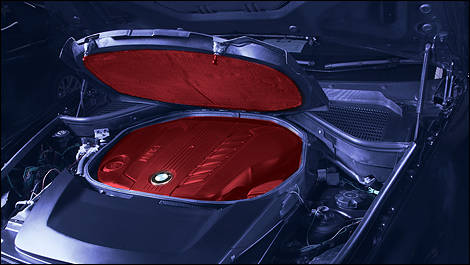Press release
Source: BMW
For a long time every effort was made to avoid the build-up of heat in the car and, therefore, to prevent overheating of the car‘s components. But in recent years there has been a significant change in mind in the process of reducing CO2 emissions.
“Heat is a very valuable form of energy in the car largely still unused and not easy to properly exploit.” (Dr Johannes Liebl, Head of BMW EfficientDynamics)
A lot of residual heat is generated particularly in the engine, since even in a very efficient combustion engine only about one-third of the energy in the fuel consumed is actually converted into drive power. The other two-thirds are lost as waste heat going out into the environment through the exhaust gas and the radiator.
Use of this energy through intelligent heat management offers a great potential for reducing fuel consumption and, accordingly, CO2 emissions. While a small share of the thermal energy available is already used today (for example when warming up the engine or through exhaust gas turbocharging), further improvements for using such thermal energy would be able to reduce the car’s consumption once again by several percentage points.
Depending on the context and the route profile, heat management offers various possible solutions, different technologies serving to reduce fuel consumption on both short and long distances. Insulation of the engine compartment, use of an exhaust gas heat exchanger on the petrol engine to heat up the transmission fluid, or the heating function of the exhaust gas heat exchanger on a diesel engine are appropriate options mainly for short distances. On longer routes the Thermoelectric Generator is able to make a signifi cant contribution to greater fuel economy.
Using synergy effects, heat management will make a substantial contribution in future to the reduction of CO2.
No More Cold Starts
When starting the engine cold and while warming up, there are signifi cant frictional losses in both the engine and the transmission, resulting in an increase in fuel consumption of up to 10 per cent versus the engine already warm. Precisely this is why the objective today is to warm up a car as quickly as possible to its regular operating temperature. At the same time it is important to maintain the temperature within the car as long as possible also at the end of a trip, in order to have the optimum temperature in the engine when starting again, thus offering the customer further advantages in terms of fuel economy.
Encapsulation of the engine is a viable solution on both petrol and diesel power units. The objective of such insulation is to retain as much heat within the engine as possible at the end of a trip in order to have the ideal engine temperature when starting again.
Source: BMW
For a long time every effort was made to avoid the build-up of heat in the car and, therefore, to prevent overheating of the car‘s components. But in recent years there has been a significant change in mind in the process of reducing CO2 emissions.
 |
| Project Heat insulation on the engine. |
“Heat is a very valuable form of energy in the car largely still unused and not easy to properly exploit.” (Dr Johannes Liebl, Head of BMW EfficientDynamics)
A lot of residual heat is generated particularly in the engine, since even in a very efficient combustion engine only about one-third of the energy in the fuel consumed is actually converted into drive power. The other two-thirds are lost as waste heat going out into the environment through the exhaust gas and the radiator.
Use of this energy through intelligent heat management offers a great potential for reducing fuel consumption and, accordingly, CO2 emissions. While a small share of the thermal energy available is already used today (for example when warming up the engine or through exhaust gas turbocharging), further improvements for using such thermal energy would be able to reduce the car’s consumption once again by several percentage points.
Depending on the context and the route profile, heat management offers various possible solutions, different technologies serving to reduce fuel consumption on both short and long distances. Insulation of the engine compartment, use of an exhaust gas heat exchanger on the petrol engine to heat up the transmission fluid, or the heating function of the exhaust gas heat exchanger on a diesel engine are appropriate options mainly for short distances. On longer routes the Thermoelectric Generator is able to make a signifi cant contribution to greater fuel economy.
Using synergy effects, heat management will make a substantial contribution in future to the reduction of CO2.
No More Cold Starts
When starting the engine cold and while warming up, there are signifi cant frictional losses in both the engine and the transmission, resulting in an increase in fuel consumption of up to 10 per cent versus the engine already warm. Precisely this is why the objective today is to warm up a car as quickly as possible to its regular operating temperature. At the same time it is important to maintain the temperature within the car as long as possible also at the end of a trip, in order to have the optimum temperature in the engine when starting again, thus offering the customer further advantages in terms of fuel economy.
Encapsulation of the engine is a viable solution on both petrol and diesel power units. The objective of such insulation is to retain as much heat within the engine as possible at the end of a trip in order to have the ideal engine temperature when starting again.





